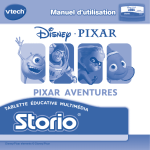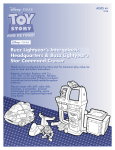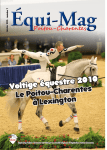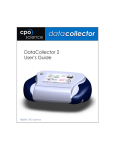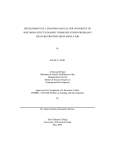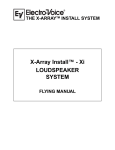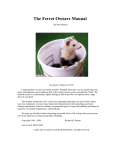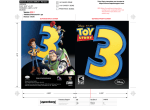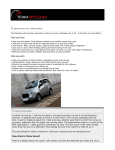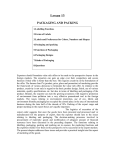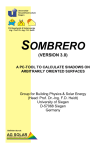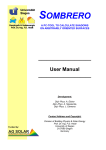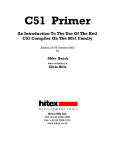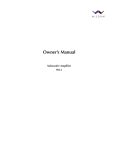Download Guidebook
Transcript
Guidebook Contents Read This: Things To Do & Think About Before Playing Contents Of Packaged Pair . . . . . . . . . . . . . . . . . . . . . Thank You & Welcome to Zu . . . . . . . . . . . . . . . . . . . . . Warnings: Health & Safety . . . . . . . . . . . . . . . . . . . . . . Materials, Regulations, & Disposal. . . . . . . . . . . . . . . . Environmental Statement. . . . . . . . . . . . . . . . . . . . . . . Initial Placement of Loudspeakers . . . . . . . . . . . . . . . . Binding Posts & Input Terminals . . . . . . . . . . . . . . . . . Recommended Reading On Acoustics . . . . . . . . . . . . . . Placement Fine Tuning / Tone. . . . . . . . . . . . . . . . . . . . Placement Fine Tuning / Stereophonic . . . . . . . . . . . . . Burn-in . . . . . . . . . . . . . . . . . . . . . . . . . . . . . . . . . . . . Grille. . . . . . . . . . . . . . . . . . . . . . . . . . . . . . . . . . . . . . Loudspeaker Cables. . . . . . . . . . . . . . . . . . . . . . . . . . . Maintenance & Cleaning of Finish . . . . . . . . . . . . . . . . Maintenance & Cleaning of Input Terminals. . . . . . . . . Warranty & Service Information. . . . . . . . . . . . . . . . . . Loudspeaker Components Wire Frame . . . . . . . . . . . . . Specifications. . . . . . . . . . . . . . . . . . . . . . . . . . . . . . . . . . . . . . . . . . . . . . . . . . . . . . . . . . . . . . . . . . . . . . . . . . . . . . . . . . . . . . . . . . . . . . . . . . . . . . . . . . . . . . . . . . . . . . . . . . . . . . . . . . . . . . . . . . . . . . . . . . . . . . . . . . . . . . . . . . . . . . . . . . . . . . . . . . . . . . . . . . . . . . . . . . . . . . . . . . . . . . . . . . . . . . . . . . . . . . . . . . . . . . . . . . . . . . . . . . . . . . . . . . . . . . . . . . . . . . . . . . . . . . . . . . . . . . . . . . . . . . . . . . . . . . . . . . . . . . . . . . . . . . . . . . . . . . . . . . . . . . . . . . . . . . . . . . . . . . . . . . . . . . . . . . . . . . . . . . . . . . . . . . . . . . . . . . . . . . . . . . . . . . . . . . . . . . . . . . . . . . . . . . . . . . . . . . . . . . . . . . . . . . . . . . . . . . . . . . . . . . . . . . . . . . . . . . . . . . . . . . . . . . . . . . . . . . . . . . . . . . . . . . . . . . . . . . . . . . . . . . . . . . . . . . . . . . . . . . . . . . . . . . . . . . . . . . . . . . . . . . . . . . . . . . . . . . . . . . . . . . . . . . . . . . . . . . . . . . . . . . . . . . . . . . . . . . . . . . . . . . . . . . . . . . . . . . . . . . . . . . . . . . . . . . . . . . . . . . . . . . . . . . . . . . . . . . . . . . . . . . . . . . . . . . . . . . . . . . . . . . . . . . . . . . . . . . . . . . . . . . . . . . . . . . . . . . . . . . . . . . . . . . . . . . . . . . . . . . . . . . . . . . . . . . . . . . . . . . . . . . . . . . . . . . . . . . . . . . . . . . . . . . . . . . . . . . . . . . . . . . . . . . . . . . . . . . . . . . . . . . . . . . . . . . . . . . . . . . . . . . . . . . . . . . . . . . . . . . . . . . . . . . . . . . . . . . . . . . . . . . . . . . . . . . . . . . . . . . . . . . . . . . . . . . . . . . . . . . . . . . . . . . . . . . . . . . . . . . . . . . . . . . . . . . . . . . . . . . . . . . . . . . . . . . . . . . . . . . . . . . . . . . . . . . . . . . . . . . . . . . . . . . . . . . . . . . . . . . . . . . . . . . . . . . . . . . . . . . . . . . . . . . . . . . . . . . . . . . . . . . . . . . . . . . . . . . . . . . . . . . . . . . . . . . . . . . . . . . . . . . . . . . . . . . . . . . . . . . . . . . . . . . . . . . . . . . . . . . . . . . . . . . . . . . . . . . . . . . . . . . . . . . . . .2 .2 .3 .3 .4 .4 .5 .5 .6 .6 .8 .9 .9 .9 .9 10 .11 12 13 Read This Things To Do & Think About Before Playing ◆ ◆ ◆ ◆ ◆ ◆ ◆ ◆ ◆ ◆ ◆ ◆ Don’t clean your tweeters with compressed air or vacuum cleaner. In fact, don’t even blow on ‘em. The ribbon element of the tweeter (shiny bit under the screen) can be torn. If you want to dust your speakers with a can of compressed air, or some kind of vacuum, you must tape over the entire screen element of the ribbon tweeter. Dusting the 10” driver with compressed air is recommended. Remove the protective plastic shipping disc covering the full-range driver. Remove the protective tape covering the ribbon tweeter’s ribbon diaphragm before listening. Make sure the rooms you are unpacking and positioning the Essence in are clean; the last thing you want is to trip on the vacuum cleaner cord or slip on the album liner notes you left out, crashing your new speaker into your wall, or worse. Make sure you are button, snap, buckle, and jewelry free before handling (really stinks when you scratch ‘em right out of the box). Avoid damaging your amp; switch your power amplifier off prior to connecting the loudspeaker cable. Connect the loudspeaker cable with the red “positive” lead to the red (+) input lug: and the black “negative” lead to the black (–) input lug. Matte fi nish: do not wax or polish, in fact, only use a damp cloth for cleaning, preferable a shammy (chamois) or microfiber cloth. Gloss: dust and clean the fi nish with the supplied microfiber cloth. Lightly wet with water a quarter of the cloth for use on areas that have been handled with greasy hands. Wax or household polish or cleaners are not recommended. If you want the highest possible shine on the gloss fi nish option, Zu recommends using the supplied 3M® Perfect-It™ 3000 Final Glaze (also available at most fi ne auto detail shops). Switch your amp on and get some music going; Essence will take a week or so, depending on shipping conditions, to open up. Place Essence in a classic stereo arrangement but with a wide spread, making sure the loudspeakers are mirrored and toed-in. All parts used within Essence are 100% recyclable. Essence does not contain any toxic material as fi nished but does contain a neodymium (Nd) compound which must be recycled properly. Any Zu product or part may be sent back to Zu, free of charge, for proper reuse or disposal. Contents Of Packaged Pair (2) Matched Essence loudspeakers (2) Grille Installed User Adjustable Parts (8) ball-end feet, installed (thread size is 3/8 - 16 ) (8) 5/8” hex, stainless-steel jam nuts, installed (3/8 - 16) Additional Items Included In Package (8) carpet spikes (3/8 -16) (1) copper polishing kit for copper lugs on input terminals (1) small bottle of 3M® Perfect-It™ 3000 Glaze Polish (gloss finish only) (1) microfiber cloth or shammy for dusting, cleaning and use with 3M® Perfect-It™ 3000 Glaze Polish (1) guidebook 2 Thank you Th ank you for your purchase of the Essence loudspeaker. Every element is designed for a lifetime of trouble free high performance playback. It is our desire to exceed your expectations in product performance, quality, durability and service. If we have simply met your expectations or have fallen short, we would sincerely appreciate knowing how we may improve. Traveling the line of time we can see many periods of increased awakening and technological advancement but none so powerful and rapid as that of the Scientific Revolution, Enlightenment and the birth of modern physics. The dramatic increase of understanding regarding possibility, vibration and energy coincide with our collective ability to listen and express patterns of life. David Toop in his book Ocean Of Sound paints a powerful image of our modern musical creativity: “...starting with Debussy in 1889, is an erosion of categories, a peeling open of systems to make space for stimuli, new ideas, new now, this environment included sounds of the world—previously unheard musics and ambient sounds of all kinds, urban noise and bioacoustics... unfamiliar tuning system and structuring principles, improvisation and chance.” Awareness of surroundings, songs of tranquility and warning... history and intuition teach us that patterns of sound have been a fundamental constant of life, and the observance of nature reveal the endless interplay of vibrational forces. Welcome to Zu Sean Casey, Adam Decaria, and the entire Zu team. Warnings: Health & Safety WARNING / Children Never leave children unattended around your playback system. Care should be taken while positioning, packaging, connecting, or working around any loudspeaker. And never let children (or adults) roughhouse near your loudspeakers. Not only do you want to avoid damage to your gear (we know that’s your main concern) but you want to avoid damage to your family and friends. WARNING / Electric Shock Electrocution through loudspeaker cable is possible, though very unlikely. To avoid electrocution or damage to gear, make sure your amplifier is powered down prior to connecting or disconnecting loudspeaker cables. Also, avoid using your audio system during a lightning storm. ◆ CAUTION / Handling Wash your hands and make sure you are button, snap, buckle, and jewelry free before you handle Essence loudspeakers. ◆ CAUTION / Lifting & Positioning Get help when moving and positioning your loudspeakers, especially if you have a bad back or are accident prone. Here is the Zu in-house method for moving and positioning Essence loudspeakers • Face loudspeaker, double check you aren’t wearing anything that will mar the loudspeaker’s finish. • Install the plastic full-range driver shipping disc. Bend your knees slightly and embrace the speaker with a hug. • Straighten your knees; you are now carrying the loudspeaker with it just a few inches off the ground. • Move the loudspeaker into position then lower it by bending your knees. ◆ CAUTION / Ribbon Tweeter The tweeter used in the Essence will be damaged by high winds, tearing the aluminum foil diaphragm. Never use compressed air around it without protecting it with masking tape; don’t package or transport them without protecting the tweeters with masking tape. Avoid blowing on them. Apart from wind damage the ribbon tweeter is a solid and a tough design, but in the event that you let your kids play with the compressed air hose around your speakers, and a tweeter was torn, please give us a call and we’ll get you fixed up. ◆ CAUTION / Magnetic Field Essence loudspeaker drivers create magnetic fields that extend far beyond the boundaries of the cabinet. We recommend you keep magnetically sensitive electronics and media at least 3 feet (90cm) from the loudspeaker. ◆ CAUTION / High Sound Pressure Level Potential Essence loudspeakers are capable of extreme sound levels—play responsibly. 3 Materials, Environmental Regulations, & Disposal All parts used within Essence are 100% recyclable. Essence loudspeakers do not contain any toxic material as fi nished, but does contain a neodymium (Nd) alloy which must be recycled properly. Any Zu product or part may be sent back to Zu, free of charge, for proper reuse or disposal. Zu Essence loudspeakers are RoHS compliant (European Union’s Directive 2002/95/EC, Restrictions of Hazardous Substances), and therefore do not contain any of the following substances: mercury (Hg), cadmium (Cd), hexavalent chromium (Cr6+), polybrominated biphenyls (PBB), or polybrominated diphenyl ether (PBDE). Additionally, Zu Essence loudspeakers do not contain beryllium (Be). Zu Essence are classified as a lifetime life-cycle product and will most likely be in service for well over 50 years. Environmental Statement Zu takes pride in it’s hard work, innovation, engineering and manufacturing know-how, and at the end of it, a well built product. Zu is sincere in its search for real environment and human / ecological friendly manufacturing, no fluff y feel good bullshit, just the real deal; and not because of some great googly moogly “climate change” geopolitical power play nonsense. It’s simple isn’t it? People like being healthy and enjoying clear skies, green hills and wildlife. We keep our impact to a minimum because we get out and enjoy nature and don’t want to mess it up. Zu makes good stuff, products that last, things you can pass down to your kids and their kids, stuff that isn’t going to end up in landfi lls. Want to make a difference? Do a litt le research on your own before you fall for hype, support a cause, discriminate, or purchase a product. The founders of Zu believe that manufacturers and users have equal responsibility and an obligation to their respective communities. Users and producers must search for real solutions and maximize their positive impact on family, community, nature, and technology. Personal responsibility. Vector by Katherine Waterman gaaralover112.deviantart.com/gallery 4 Initial Placement of Loudspeakers To avoid damage to your flooring use the pre installed ball-end feet for hard surfaces, and the supplied spikes for carpet. Place the speakers where you had planned. Connect the loudspeaker cables; red to red on both the amplifier and loudspeaker. Put some music on and light ‘em up. Now, take a half hour and read the rest of this guidebook. While Essence loudspeakers are burned-in for several weeks prior to shipping, they will still require a week or two of play to relax and open up. If you position and tune them for best sound during this time please take time to retune after they have sett led in. Essence loudspeakers are not overly sensitive to placement. However, for best sound we recommend you take time to optimize and integrate the loudspeakers with the acoustic nature of the living room or space, as well as optimizing for your sonic quality preferences. But for now, lets just get them up and running and sounding good, in a place in the room that you, your family and friends can appreciate and live with. After all, if you don’t have convenience and good looks from your playback system, you aren’t going to get the amount of use you desire. In most cases of architecture and room flow, position the loudspeakers to balance the natural seating / facing position within a room. Architecture that is livable and att ractive almost always sounds good, loudspeakers that look out of place within a room usually sound out of place. And as with art of this size: monoliths, pottery, statuettes, Essence loudspeakers need enough open space to both visually and audibly appear relaxed. Loudspeakers crammed up against the wall, corner, furniture, or other pieces of art, do not look good and do not sound as good as they could. The amount of free space is usually predicated by the room size and shape, bigger rooms with higher open areas seem to demand more free space around the loudspeakers. Smaller rooms require less. No ruler required, what looks good will very likely sound good. If you hold convincing stereophonic recreation as a desirable sonic att ribute (for some stereophonic is a secondary, or even unimportant aspect of fidelity; and yes there are good reasons for it) then you must also work in symmetry. For good stereo effect channels must be precisely mirrored, left / right, and addressing / illuminating the focal point of the living / gathering space. Th is aspect is detailed in the Fine Tuning section. The Zu approach to be reasoned out as you tune your playback system to your space: Essence loudspeakers should be placed to work with the natural acoustics of the room rather than fight them, and in most every case, where they will sound best is also where they will look best. Professional audio engineers aside, we strongly recommend that you place your speakers with your eyes and ears fi rst. Audiophiles, please fight the urge to set them up based on what has been handed out in the popular magazines and internet. Generally, the information found there is over simplified and wrapped in jargon thus obscuring the problem and reason for the proposed solution. If you are a student of Olson, Jeans, Rayleigh... do your thing, and realize there is a strong aesthetic undertone in all the great works of acoustics. Gett ing good sound is not as hard as you might think, so long as you... yep, think with your eyes and ears and not with your brain. What most of us regard as architecturally att ractive is at least subconsciously influenced by how a structured space sounds. Laying out a system based on room flow and visual appeal usually results in good sound, and speakers shoved in corners are not an example of appealing visual integration. If you only have a random or even less than scholarly understanding of acoustics we again encourage you to plan with your eyes and ears, and less with your brain and measuring tape. Please continue reading through the Placement Fine Tuning sections on Tone and Stereophonic. Binding Post & Input Terminals All connections should be made with the equipment powered down. Make sure you connected the red (+) output of the amplifier to the red (+) input of the loudspeaker, and likewise (–) to (–). Essence loudspeakers features Cardas® pure copper unplated binding posts and are internally terminated using a high pressure crimp system in place of solder. They accept standard and oversized spade lugs, bare wire and banana plug. While they accommodate a wide array of terminals we recommend spade lugs with strong recommendation on the use of our unplated pure copper spades. In some countries, 4mm banana plugs are considered a safety hazard; and of similar interest, the binding posts featured on the Essence comply with CE standards. (–) BLACK Input Size: 1/4” lug (6.3 mm) (+) RED Input Size: 1/4” lug (6.3 mm) 050 5 Recommended Reading On Acoustics Whatever the reason, the current consumer playback world is generally lost in its conception of acoustics and the nature of sound—much has been written in the hi-fi world but litt le of it is genuine. Original recommended works on the subject representing a good cross-section include: Helmholtz, Hermann L. F., On The Sensations of Tone, 4th ed. trans. Alexander J. Ellis (Dover, 1954. Original 1885-77) Rayleigh, J.W.S. Baron, The Theory of Sound, 2nd ed. Vol. 1 & 2, (Dover, 1945. Original 1894) Lamb, Horace, Sir, The Dynamical Theory of Sound, 2nd ed. (Dover, 1960. Original 1925) Jeans, James, Sir, Science & Music, (Dover. Original 1937) Olson, Harry F., Music, Physics and Engineering (Musical Engineering), 2nd ed. (Dover, 1967. Original 1952 & 1967) Benade, Arthur H., Fundamentals of Musical Acoustics, 2nd ed. (Dover, 1976, 1990) Kinsler, Frey, Coppens, and Sanderds, Fundamentals of Acoustics, 3rd ed. (Wiley, 1982) Placement Fine Tuning / Tone The following technique is Zu Essence specific (though it likely works well for most other loudspeakers) and assumes a traditional “on the main wall” placement. It addresses the loudspeaker’s relationship with the room and att aning good tone / timbre. How and where the loudspeakers excite the room and how the room reacts is relative to the type and source of excitation and room reactance. These are a function of boundaries (walls, floors, etc.), boundary properties (mass, compliance, Q , damping, texture and structure), area impedances (shape, volume), diff usion and absorption (furnishings, people, flooring, etc.), source and type of wave excitation (loudspeaker design and placement), resonators (closets, forced air ducting, hallways, etc.), even atmospheric pressure and humidity, though very minor, will influence sound. While the above are beyond the scope of this guidebook, the recommendations and listed books will start you down the right path. And just to drive it home, before you trust another modern work relative to playback and acoustics please research the above listed references. And if in doubt, think with your eyes and ears—listen. With your loudspeakers positioned for visual appeal and livability (read Initial Placement of Loudspeakers) you can now begin fi ne tuning the loudspeaker placement. Th is involves three major steps. In sequence they are: bass, mids and treble. If you can’t fi ne tune your system within an evening, or you fi nd the concepts difficult, do yourself a big favor and contact your supporting Zu store or local pro audio store, asking if the resident sound guy is available for hire. The expense is worth it, possibly the biggest thing you can do to get better sound. There are lots of good acoustics guys in pro, in every city there are a handful of really good guys, track ‘em down. But, hi-fi or pro guy, if they don’t know who Harry Olson is don’t hire ‘em. Seriously. There are two main areas of fidelity if bandwidth, dynamic range, and group delay (more or less timing) are assumed; and as dynamic range, bandwidth and group delay are largely set by the system, the user can’t really tune these elements anyway. Tunable elements are: tone, as used by Helmholtz and guitarist the world over; and stereophonic, the ability to recreate three-dimensional acoustic space. TONE Traditional musical instruments are tuned around the concept of tone, and there is no “stereo” in them. Designer, builder, tuner, player are all keyed in on the instruments tone. And if you can’t get tone, or the recreation of it, litt le else matters, well, to the majority anyway. So if you want to hear what Mike Watt is doing with his 1963 Gibson EB-3 bass guitar, or tell it apart from a 1966 Fender Mustang, focus on building tone in your room and system and forget stereophonic, which includes anything more than one channel, at least for now. Focus and tune just one Essence loudspeaker. Which? The loudspeaker that will be most impacted by the room, usually the one that is most framed by wall area, the side lacking a door or whatever. You will tune this for tone, with the matching Essence disconnected from the amp, with a subconscious eye on stereophonic mirroring (which we generally feel as a compelling component of playback). Once you have tuned this one channel for tone you will then get the measuring tape out and simply mirror the mate and presto, you have tone, texture, and stereophonic magic like never before and without wasting a bunch of time gett ing it. TONE BASS TUNING Select a recording that is big on tone, something monaural, with a big full sound, possibly with a baritone vocal. The Beetles Rubber Soul works prett y well and most of you should have this in your collection, make sure it’s not the stereo mix. Most anything produced by Phil Spector will also work, though they are usually a bit bass shy. Don’t use test tones, steady state sine, triangle and square wave signal prove very difficult to interpret. Full, tone rich mono recordings will enable the listener to make fast work of fi ne tuning. With the one loudspeaker playing at a moderate level, initially positioned where it looks good, walk over and kneel down next to it. Kneeling will put your head and ears in the seated listening plane and allow you to hear how the loudspeaker integrates with the room, with emphasis on the seated elevation. Now move your head to either side of, and back and forth of the loudspeaker, in big dramatic sweeps, after all, it’s big bass waves we are listening to here. Listen to the fidelity of the bass, does it sound woolly and muddy right behind the loudspeaker? Is the bass more defi ned to the left or right? If the bass sounds better to the left , move the loudspeaker to that spot and listen again. Remember that moving the loudspeaker also changes how the room reacts; however, you should only have to move the loudspeaker two, three or four times to get it right. With each listen and move, you should also listen in your center seat and try and confi rm and corollate your observations at both positions. Complicated rooms can be further modeled by walking about the whole room, noting nodes and anti-nodes within bass octaves. If you aren’t hearing much, move on, you could have it nailed or have a great sounding room. TONE MIDRA NGE & TREBLE TUNING Once the bass decade is sounding good, natural, vibrant midrange and treble can now be dialed in. Before you begin, it’s important to understand a few concepts. Midrange tuning, while similar to that of bass, is a task of inches (decimeters) rather than feet (half meters) and upper octaves a matter of half inches (centimeters) and loudspeaker fi ring (wavefront) axis. Even though midrange and treble changes can be heard at the “being positioned loudspeaker”, it is helpful to have a friend position while you listen in the seating area. 6 Staying with the same loudspeaker “room-tuned” for bass (low frequencies = long wavelengths), remember you only tune one channel and mirror its mate, and with your favorite monophonic, less bass heavy recording playing, start tuning for mids and highs. Move the Essence loudspeaker toward the closest wall, in increments of a few inches (4 - 6cm). While moving, the “in the listening area” observer, and possibly the person positioning the loudspeaker, should notice midrange color and presence transition from low and masked to open and intimate. There may be several spots within the good sounding bass area that have good presence, go with the widest point (closest to the wall) for an expansive and engaging stereo image, once you mirror the mate and run both channels. Don’t worry about center focus, Essence has no problem doing expansive and focused stereophonic. Once a midrange position is selected it’s time to work on the highest octaves (the top decade). Th is is usually as simple as rotating the loudspeaker to face a bit behind or directly at the seated listener. Now listen again for openness and intimacy, minor placement adjustments and face angle (toe-in) may be necessary. If it’s a bit too treble rich, rotate the loudspeaker to focus behind the main listening area. If still you have a bit to much treble emphasis in your room and with your electronics, rotate out a bit further. Experiment. AVOIDING WASTED TIME Take your time positioning this one loudspeaker. It’s much easier to hear and correlate what is happening from a mono recording played through a single speaker. And because of it’s natural simplicity, unclouded by stereo fog, the ears and mind have a much easier time drawing conclusions on what’s wrong with the sound. Get this one channel sounding good,and when you’re satisfied simply get the measuring tape and lasers out to mirror its mate. Additional Thoughts About Playback & Room The design of the Essence overcomes so many problems with regard to room, att ack, sustain and decay. All the att ack of the complete audio bandwidth and musical scale emanates from the Zu260FRD/G4 full-range driver. The att ack, more than any other aspect of a waveform, gives the listener the clues to process source, direction, amplitude, character, intelligence, and so on. Close in importance are the dynamics within that immediately follow the att ack. An example of the att ack phase is when a piano key is struck: you hear or sense the mechanical noises including that of the impinging hammer; then the initial string motion, which has many extra components that are quickly damped away and no longer present in the sustain; and initial coupling of piano body and sound board. The fi rst several milliseconds are very dynamic and have many features. To get the att ack correct is solely a function of the playback system and has very litt le to do with the room. Aside from placement, if you have changed your system to combat your room, att ack and dynamics can never be correct. Most people can only pinpoint tonal problems with steady-state or semi steady-state music or signal, this is a big problem because room influence on steady-state sounds are huge, the single largest influence if included as a component of your playback system. So, hi-fi guys usually tweak things to get the steady-state and decay tonally correct which inadvertently kills the life in the att ack. Th is is a reason why cables as tone control, digital room correction, parametric equalizers and the like can never “fi x” fundamental problems—unless of course the time axis is also programmed and correlated to harmonic structure and then set to react to any dynamic anomalies within the signal, overlaid with the room the original recording was made in and compared... yeah, we’re just a few years from having all that figured out. Now, on to the simple phase of stereophonic setup. 7 Placement Fine Tuning / Stereophonic Recommended Tools Strait-Line® Intersect Laser Level, or similar (inexpensive and useful for leveling wall art when you aren’t using it for fiddling with your playback system) tape measure masking tape With the one channel sounding good, gett ing convincing stereophonic effect is now simply measuring and mirroring. Don’t fuss over whether or not your speakers are perfectly square with the walls, or get obsessive with the room mathematical relationship. To do so is to waste time and possibly mess things up. Trust what you established in mono, you have laid the foundation with your single channel effort so forget about everything other than establishing your center plane and mirroring the other channel. In the mono you established two points of reference that will now establish your stereo mirror plane. Those points are your seating position and your tuned loudspeaker. 1. Measure the distance from the wall to the positioned loudspeaker’s inside forward base corner and note. 2. Sit in your center seat, with a piece of masking tape in your hand lean forward and mark the center spot of the floor, right between your feet. 3. With the Strait-Line® Intersect Laser Level in hand, stand and walk straight ahead to the facing wall. Butt the Intersect Laser Level up against the wall and position the Intersect Laser Level so the side plane laser indicator runs parallel with the wall, and the center plane intersects your seating center mark. 4. From the wall, along the center laser mark toward your seating, measure off the same distance as in step one, and mark with a bit of masking tape. These two points establish your stereo center plane. 5. Move the Intersect Laser Level forward so the intersection is on that bit of masking tape nearest the wall and the center laser mark intersects your seating center mark. Th is should result in the orthoginal laser striking the tuned loudspeaker right on the inside front corner. 6. Measure the distance from the laser intersect to the point of laser contact (inside front base corner) on the positioned loudspeaker and note. 7. Reflect this distance on the other side of the stereo plane, marking the mirrored distance with a bit of masking tape. 8. Now place the second speaker’s inside front corner on this mark and approximate the toe-in by pivoting it on this inside front corner. If fi ne tuning of toe-in is needed pivot either loudspeaker on the front inside corner footer only. Th is will keep the mirrored stereo relationship the same and you wont have to get the laser and tape measure out every time you mess with toe-in. 9. While you can also use laser’s to adjust and ensure mirrored stereo toe-in, I recommend that initially you just eyeball it based on the amount and angle of the loudspeakers inside cabinet edge. Before you get “laser crazy” with toe-in I highly recommend that after you get close by eyeballing it, you then level your Essence loudspeakers with a bubble level or plum. Doing so makes for increased accuracy with laser toe-in tuning. SEATING 2 9 8 7 60° 9 4 5 3 FRONT WALL 8 6 1 Burn In All Zu loudspeakers now come with 300 hours of real music conditioning at what we consider to be the right levels in our burn-in rig. Th is puts the loudspeakers in a position to really sound good within a few days of being setup in your home, and awesome within a few weeks. We do not recommend recordings specifically designed for loudspeaker, system or cable burn-in. The quickest and most enjoyable way to fi nish the conditioning of your Zu loudspeaker is to play music and movie scores that are fun, dynamic and harmonically dense. No longer do you need to worry about cranking them up either. Let your neighbors know where they can send tips, that’s Zu in Ogden, Utah. Break-in Phenomenon: A running-in of driver suspension components is the prime influencing factor in loudspeaker break-in. Cable and electrical burn-in is also a factor but secondary. Essence loudspeakers generally go through two or three break-in sound transformations. The fi rst is mechanical, affecting bass and intimacy. We now take care of this to good effect at the factory. The second is electrical. The majority of the electrical process is taken care of at the factory, burning in the drivers with the cable assembly and high-pass network at the same time. Grille The grille on the Essence is designed to offer true protection for the drivers. Unlike basic cloth grilles which are largely cosmetic; the aluminum grilles, with the ball and socket fastening, look great and keep everything safe from all sorts of accidents. To put the grille on, simply line up the pins with the sockets and press . To remove, unplug one socket corner at a time. If the grille becomes bent simply reform it by hand and it’s good to go. Loudspeaker Cable The most common abuse in hi-fi is to use cable as a form of tone control. Doing so usually leads to frustration and further loss of fidelity. When cable affects timbre it affects timing, phase, frequency response, and so on. DO NOT USE CABLE AS TONE CONTROL. Timbre problems are usually solved with loudspeaker break-in and correct loudspeaker placement (assuming you have Essence or other loudspeakers capable of delivering tone). One last note on tonality and cable, if the cable has good properties relative to phase, gain, group delay, impedance, and bandwidth, it will likely convey with fidelity the transmitted emotion and color. For best stereophonic imaging you must run a matched pair of left / right cable that are also the same length. If tone is more your thing and stereophonic effect is not so important then length matching of left / right channels is not important. While insulation, jacket materials, pigments, conductor shape, metallurgy and structure are important (yep, they really are) all pale compared to the influence of electrostatic / electromagnetic, virtual ground plane, and conductor relational geometry. Th is fi nal E&M model, or cable geometry, largely determines measured att ributes. Essence features a Zu engineered and built, pure copper cable for internal cabling. Improvements that will be noticed from well engineered cables such as Zu, should include: bass depth and resolution, system noise floor, harmonic structure and timbre, att ack, stereophonic accuracy, easy of listening—simply a lot closer to the recorded event and a lot further from the typical hi-fi animation. But this assumes you are striving for the natural. Preferences in playback are just that, and individual enjoyment really is the goal, and not some ideal of what playback should be. If you like it animated or whatever, that’s cool too. Maintenance & Cleaning Of Finish Zu fi nishes of all types are engineered for a lifetime of trouble free good looks. Just wipe ‘em down whenever you feel the need. A lightly damp microfiber cloth or lightly damp shammy / chamois is recommended. Gloss fi nishes do not need any additional UV or other protection and we do not recommend wax. For serious cleaning and polishing we recommend 3M® Perfect-It™ 3000 Glaze Polish. All our painted fi nishes are super durable, waterproof, and will remain so for decades. Wood fi nishes are impregnated with a sealer and are highly water resistant but are not waterproof. Dusting of the 10” drivers should only be done with hand-held compressed air as used in photograph and sensitive electronics dusting. Or, if you are careful, you can use a very soft brush or even your bare hand to dust the full-range driver—but I would stick to the compressed air. Be sure to cover the ribbon tweeter’s wire mesh area with masking tape prior to using any compressed air or you will likely tear the ribbon. 9 Maintenance & Cleaning Of Input Terminals The unplated pure copper binding post terminals should be cleaned once or twice a year using the supplied polishing compound. Once you have cleaned and polished the binding posts and spade lugs (if you are also using our unplated pure copper spade lugs) avoid touching the spades or the binding posts. Keeping the contacts free of the halides on your skin help ensure a long term and trouble free connection. Instructions for cleaning and polishing the binding posts. 1. 2. 3. 4. 5. 6. Wash your hands with soap and water prior to cleaning the terminals. Completely remove the binding post knob and black plastic clamping block. Th is will make for easy access of the copper lugs. Using the supplied pink colored polish cloth (labeled “copper polish”) rub the exposed copper lug until it is clean, usually about 15 to 30 seconds is all that is needed. Before the polish dries, wipe polish off the copper lugs with the supplied buffi ng cloth. (DO NOT WASH POLISH OFF WITH CONTACT CLEANER, POLISH MUST BE REMOVED BY BUFFING ONLY.) Refit the black plastic clamping block, red mark up, and binding post clamping knob. Again wash your hands with soap and water. The pink polishing cloth does contain a small amount of petroleum distillate. The supplied pink polishing cloth is good for roughly ten years or one hundred binding post cleaning’s and should be stored and tightly sealed to keep it from drying out. The pink polishing cloth should be replaced if it becomes dry or if it becomes excessively dirty (all black and gray with no pink). If you are also using our loudspeaker cable fitted with our pure copper spade lugs, we recommend that you clean your spades the same time that you clean the binding posts. Polish each spade for 15 to 30 seconds then buff with the white buffi ng cloth. 10 Warranty & Service Information Zu products are designed and manufactured to the highest quality. However, if something does go wrong Zu will fi x or replace the product free of charge. Zu Essence loudspeakers have a five year limited warranty from date of purchase to original owner. If under normal home use you have any problems with drivers, cable, parts, cabinet, we will fi x or replace the product. Loudspeaker warranty and service can usually be performed by the user, also known as DIY Service, in such cases Zu will provide full technical support, instructions usually including a DVD video, and any special tools. Th is provides faster repair of product (reducing down time is always good), minimizes handling hassle and damage potential to both Zu and you, and reduces shipping costs. Zu loudspeaker fi nish warranty covers color changes in paint, fi nish checking, and oxidizing. Wood fi nishes are not guaranteed against fading and you should keep them out of direct sunlight, just like a piano. While every effort is made to ensure a perfect fi nish that will last a lifetime, this warranty does not cover damage from impact and abrasion; or seam / core construction visibilities in extreme high temperature / high humidity environments. All standard Zu cables have a limited lifetime warranty with the exception of the Mobius headphone cable which has a two-year limited warranty. Cable warranty does not cover misuse or broken connectors damaged from misalignment or over tightening. Limited lifetime warranty is available to the original purchaser only. Zu phonograph cartridges have a limited two year materials and workmanship warranty. Th is warranty does not cover misuse or accident. It does not cover premature stylus wear from playing dirty records. And it does not cover broken cantilevers—a clear sign of misuse. Zu products are designed to be used in temperature and humidity controlled environments, namely your home or office unless otherwise stated. Warranty does not cover loudspeaker fi nish damage caused by the extremes of an uncontrolled environment. If in the highly unlikely event that a Zu product arrives to you Dead On Arrival (D.O.A.), and after discussing it with a Zu tech, we will ship another of the same product at our expense and arrange for the D.O.A. product to be collected. If after inspection we fi nd that you have misrepresented a returned product’s condition, and that it was improperly handled or used, Zu will charge you for all damaged parts, labor, shipping and handling of the product. Warranty does not apply to damage caused by operating the product outside the intended use, accident, another product, misuse, abuse, flood, fi re, earthquake or any other external causes. Warranty does not cover damage caused by modification or service performed by anyone other than a Zu representative. Cosmetic damage is also excluded from warranty, as is all product that has any part of the Zu serial number removed. When a product or part is exchanged the replacement becomes your property and the suspect or damaged part becomes Zu’s property. Parts provided by Zu must be used in products for which the warranty service is claimed. WHAT YOU CAN EXPECT IF WARRA NTY SERVICE IS NEEDED Cable: exchange for new or at least functionally equivalent to the original cable product, or repair. Loudspeakers: replacement of product or parts including user-serviceable parts, or repair. Phonograph cartridges: exchange for new or at least functionally equivalent to the original product, or repair. If warranty becomes necessary, you must call or email for a Return Material Authorization (R.M.A.) number, or to arrange for user serviceable parts. Th is provides opportunity to assist in diagnosing the problem and helps us to schedule for rapid turnaround in the event that parts, service or repair is needed. Upon factory inspection of parts or product, warranty eligibility will be determined. While service options, parts availability and response times will vary, we do our best to keep you happy and strive for same day turnaround on cable problems, and one to three day turnarounds on phonograph and loudspeaker problems. Depending on the situation you may be responsible for shipping and other charges. International customers should know that Zu will comply with all applicable export / import laws and regulations, you may be responsible for custom duties, taxes, broker fees, freight, and other charges. When shipping of product or part is required, repackage the complete product, or part, in its original packaging. If you have any questions about packaging please call or email. Product damage caused from incorrect repackaging is not eligible for refund or warranty and the freight company may also reject your insurance claim. Until we have the product back in the shop and sign-off that it is eligible, the product is still your property, we recommend you insure or declare the full value when shipping. We also recommend that you only ship with a freight company that has a good reputation and offers tracking and insurance for the full amount. Within the package you need to also include your contact information. ZU AUDIO ATT ENTION REFUND + RMA NUMBER OGDEN COMMERCIAL INDUSTRIAL PARK 3350 S. 1500 W. OGDEN, UT 84401 USA SALES INFO | PRIVACY POLICY | COPYRIGHT information available at www.ZuAudio.com 11 Loudspeaker Components Zu Essence Loudspeaker Wire Frame Zu260FRD/G4 Full-range Transducer 101/3” (263mm) loudspeaker driver (traditional dynamic transducer) Manufactured in USA by Zu Audio and Eminence. Engineering by Zu, Eminence, Rh, WE. 18 ply Baltic birch internal baffle Ribbon Tweeter Ribbon diaphragm is the shiny aluminum portion behind screen. Nb alloy motor. Manufactured by TB in Taiwan (all other sub-assemblies made by Zu Audio in USA) High-Pass Tweeter Network 2nd order Bessel based, all terminations forged, or terminal strip. 3/4” (19mm) MDF Cabinet High precision CNC machined with voidless V-groove seems using TiteBond-3 adhesive. Internal Zu Cable Harness Pure copper conductors, high conductance, PE dielectrics, high EMI immunity, direct forged to input terminals, 1/4” FastOn™ terminals forged at voicecoil. ZuRG™ (Griewe Technology) Internal Cartridge Damping, resonance control, acoustic impedance matching. Original to Zu. Name Plate Includes serial number and other useful data. Input Interface / Binding Post Cardas® Patented Binding Post. Accepts standard 1/4” (6.3mm) and oversized 5/16” (8mm)spades (forks), pins,, bare wire, 1/4” and 5/16” ring lugs. Banana plugs can also be inserted between copper lugs and clamping block. Base With ZuRG Fixed Gap Perimeter Slot Feet / Spikes 3/8” -16 threads, 9/16” nut (14mm), hardwood ball-end feet installed. Includes 3/8”-16 spikes. 12 Essence Loudspeaker Specifications April 2009 (Production Version 1) Design Essence is a high efficiency, high output, direct radiating floor standing loudspeaker. It features a full-range Zu designed and built driver, full implementation of the ZuRG (Griewe) loading with fixed gap height, no crossover or filters on full-range driver, complimented by a high output transformer coupled ribbon tweeter to provide the sparkle and resolution from 10k Hz and up. Version 1.0 Launched January 2009, production units began shipping March 2009 HWD Footprint Weight Packaged 49” x 12” x 12” (125 x 30.5 x 30.5 cm) 121/2” x 121/2” (32 x 32 cm) 65 pounds (29.5 kgs) One per shipping box, 73 pounds (33 kgs) 43” x 16” x 15” (137 x 41 x 38 cm) Driver Compliment Zu260FRD/G4, 10-1/3” full-range driver covering 30 to 10,000 cps (Hz) Component Tolerance TB-1855S-B ribbon tweeter with final foil adjustment and assembly by Zu driver >1% pair matching, 0.1% on all other electrical components. Recommended Connector 1/4” spade (6.3mm fork) Accepted Connectors Also accepts oversized spades, standard and oversized ring lugs, bare wire, pins, & banana plugs in a pinch. Banana plugs are clamped between clamp block and copper lugs and are not socketed Efficiency 97 dB @ 1 Watt, 1 meter Impedance 12 Ω, nominal full bandwidth, 9 Ω minimum Average Room / Moderate Volume Large Room / Loud Large Room / Concert Level Max Music Input Power (Full Bandwidth) Max sustained RMS Power (Full Bandwidth) Bandwidth Group Delay Dynamic Range Horizontal Acoustic Center Horizontal Listening Window Vertical Listening Window 2 - 8 Watt 8 - 30 Watt 30 - 80 Watt 300 Watt 200 Watt 30 - 40,000+ < 5 ms 120 dB 40” (101 cm) 45˚ 40˚ Full-range Driver Network None Super-tweeter Network high-pass second order Bessel based, 10k mathematical (12k+ acoustic) Internal Cabling Zu Mission, pure copper, approximate conductor area is approximately 13 AWG per charge Cabinet MDF / Baltic birch Spike / Feet Insert Thread 3/8 - 16 TPI (9/16” hex nut, 14mm wrench can be used but is tight) Standard Finishes Contact Zu for current offerings Custom Finishes Without Upcharge Zu Smooth Matte in Charcoal, Moss, Sage, Dune, Cobalt, or Phoenix red. Contact for possible additions. Custom Finishes ...Limitless... priced quoted per job. Zu uses PPG™ Vibrance™, Spies-Heckler™, DuPont™ Chroma, and House of Kolor™ materials Included With Loudspeaker hard-surface ball-end footers installed with S.S. 9/16” jam nuts. Also included are carpet spikes, owners manual, polish cloth, and copper lug cleaning kit. Manufacturers Country Of Origin U.S.A. all parts and labor excluding the TB ribbon tweeter which is a product of Taiwan Life Expectancy Lifetime on cabinet, 40 years plus on Zu260FRD/G4, 15 years on ribbon foil (serviceable) Warranty & Service 5 years limited, does not cover misuse or abuse. Essence is designed to be field serviceable, video and written service manual under production. 13 Zu Audio Ogden Commercial Industrial Park 3350 S. 1500 W. Ogden, Ut 84401 U.S.A. +1-801-627-1040 www.ZuAudio.com 14














